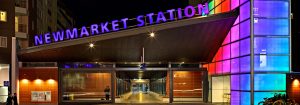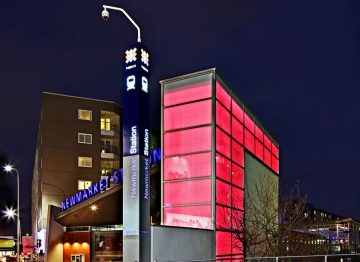See how Philips coloured LED solutions bring architectural icons to life at Newmarket Train Station.

Lighting the New Market station,
Auckland, New Zealand
We wanted a significant entrance feature that would draw people into the station and establish a clearly identifiable landmark for Newmarket. This was certainly achieved with the lantern box.- Fergus Gammie, Chief Executive for the Auckland Regional Transport Authority (ARTA)



Customer challenge
"To create an ‘out there’ interactive visual experience” was the challenge lighting designer Simon Fong was given: the task was to develop a solution to effectively illuminate a three storey lantern box structure at the front entrance of the newly redeveloped Newmarket Railway Station.
The right lighting
Simon and his team also faced the challenge of illuminating the front wall of the newly built staff room accommodation pod, which is covered with glazed panels with a map graphic of the Newmarket area in the late 1800s. The group needed to come up with an innovative lighting design to achieve the right amount of light output and colour to complement the distinct colours used in the map graphic and not over saturate the graphic textures. The same Philips LED lighting solutions used in the lantern box were also the ideal solution to bring this modern ‘heritage’ feature to life.
How did they do it?
The lantern box and accommodation pod are both internally lit using iColor Flex SLX Nodes from Philips Color Kinetics, which are made up of a strand of 50 individual LED nodes that span the glazed panels on both of the structures. The nodes are a combination of red, green and blue LEDs and can generate any colour at any time. It is the first time in New Zealand that this type of solution has been used on structures of this size.
For the staff room accommodation pod, the lighting team found a white light produced by the LED nodes best suited the colour scheme of the map graphic because it enhanced the colours of the historic map and created a sense of warmth in the surrounding area.
The LED nodes were strategically placed across the panels of both structures to create a uniform lighting effect and prevent shadowing. For the lantern, another key design requirement was to minimise light spillage onto adjacent properties to prevent visual discomfort to neighbouring residents and drivers in the area. Philips lighting Project Manager Roger Morgan says the iColor Flex SLX Nodes were the perfect solution for both structures because they have the ability to produce an interactive lighting experience through a combination of colours, display patterns, animations and low resolution images. The LED nodes have a life span of around 50,000 hours, ensuring only a minimal amount of maintenance is required and they will not need replacing for around 17 years based on an 8 hour a day operation. The individual LED nodes can also be removed and recycled and use 10% less power compared to fluorescent lighting solutions. “Not only are the lighting solutions innovative but they’re also incredibly efficient. The energy savings are impressive when compared with conventional light sources and long-lasting products such as the Philips LED solutions cater to the growing demand from consumers for products that are both environmentally responsible and well designed,” said Mr. Morgan.
The lantern box and staff room accommodation pod wall are controlled primarily by the Philips Light System Manager (LSM) installed on site, which is used to programme the LED nodes to output the predetermined colours and shows. The LSM is connected back to the main control room in Britomart Station where the overall control and on/off switching is controlled.



